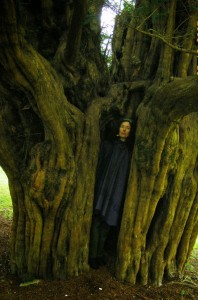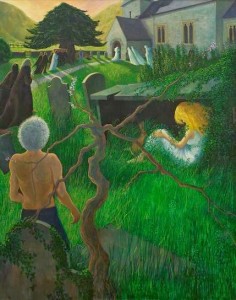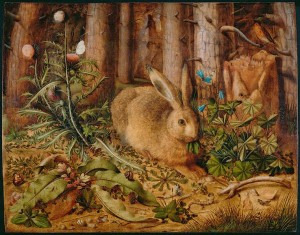 In the deep fastnesses of the Berwyn Mountains stands a small church surrounded by ancient yews more than 2000 years old. It is dedicated to the Celtic holy woman, Melangell, who came there in the sixth century. Legend tells how a prince named Brochwel was out hunting in the forest when his hounds started a hare. The terrified creature ran as fast as the wind and sought refuge in a bramble thicket. The prince galloped after the eager pack, urging them to move in for the kill, but was astonished to find them backing away, their tails between their legs. The more he shouted, the more the dogs fled howling in fear.
In the deep fastnesses of the Berwyn Mountains stands a small church surrounded by ancient yews more than 2000 years old. It is dedicated to the Celtic holy woman, Melangell, who came there in the sixth century. Legend tells how a prince named Brochwel was out hunting in the forest when his hounds started a hare. The terrified creature ran as fast as the wind and sought refuge in a bramble thicket. The prince galloped after the eager pack, urging them to move in for the kill, but was astonished to find them backing away, their tails between their legs. The more he shouted, the more the dogs fled howling in fear.
Brochwel rode up to the thicket, and there he saw a beautiful maiden, deep in divine contemplation. The hare was crouched under the hem of her cloak, its wide amber eyes boldly facing down the dogs. The astonished prince asked the young woman how long she had dwelt alone in so remote a spot; she replied that in fifteen years she had never seen the face of man. She gave her name as Melangell, the daughter of an Irish king who wanted her to marry an old chieftain. Swift as a hare she fled to Wales to preserve her virginity and live a holy life in the wilderness of the Tanat valley. The prince was so moved by her story that he gave her this part of his lands to be a sanctuary forever. Hares were given her special protection and it was forbidden to hunt them. From that time forth they accompanied her everywhere she went, and became known as “Melangell’s lambs.”
Melangell’s reputation for holiness grew, and pilgrims from all over Wales made the dangerous journey over boggy moorland and through treacherous mountain passes, seeking healing and refuge, as the hare had once done, beneath her cloak of compassion. Many miracles took place at her woodland sanctuary and sacred spring on the hillside above. Around 1160 C.E. a stone church was built with a shrine where people could come to venerate her bones.
 But who was Melangell? Walking through the lychgate of ancient stones into this hushed and holy circle of yews, it’s tempting to believe that this was a much earlier pagan site dedicated to a pagan goddess. Archaeologists have discovered evidence of a nearby Bronze Age settlement, while many round barrows, ring cairns, and standing stones dot the higher ground testament to a long-forgotten Neolithic race. On the opposite side of the river is a rock ledge known as ‘Gwely Melangell’ (Melangell’s Bed) where the saint was said to have slept. Yet it is also known as ‘Gwely y Gawres’ (the Giantess’s Bed), presumably based on an older legend of a female giant who lived in the valley.[i]Throughout Wales and other Celtic countries, significant natural or constructed rock features in the landscape are associated with giantesses and goddesses, and are often named “the Hag’s Seat” or “the Old Woman’s Bed.”
But who was Melangell? Walking through the lychgate of ancient stones into this hushed and holy circle of yews, it’s tempting to believe that this was a much earlier pagan site dedicated to a pagan goddess. Archaeologists have discovered evidence of a nearby Bronze Age settlement, while many round barrows, ring cairns, and standing stones dot the higher ground testament to a long-forgotten Neolithic race. On the opposite side of the river is a rock ledge known as ‘Gwely Melangell’ (Melangell’s Bed) where the saint was said to have slept. Yet it is also known as ‘Gwely y Gawres’ (the Giantess’s Bed), presumably based on an older legend of a female giant who lived in the valley.[i]Throughout Wales and other Celtic countries, significant natural or constructed rock features in the landscape are associated with giantesses and goddesses, and are often named “the Hag’s Seat” or “the Old Woman’s Bed.”
 Up above the Pennant valley rears the mountain peak of Cadair Bronwen, “Bronwen’s Seat,” the highest point in the Berwyns. Bronwen may have been an early mountain goddess, perhaps cognate with Branwen, sister of the god Brân in Welsh legend. And over to the north-east on the island of Anglesey stands a megalithic chambered cairn called “Barclodiad y Gawres,” the Giantess’s Apronful. It was said to have been created by a giantess who was carrying the huge boulders in her apron. The weight was too much for the apron strings, and the stones fell to form the cairn. The same story is found in Scotland and Ireland to explain the creation of rocky hills and chambered cairns, and hints of a long-forgotten primordial myth of an earth-shaper goddess.
Up above the Pennant valley rears the mountain peak of Cadair Bronwen, “Bronwen’s Seat,” the highest point in the Berwyns. Bronwen may have been an early mountain goddess, perhaps cognate with Branwen, sister of the god Brân in Welsh legend. And over to the north-east on the island of Anglesey stands a megalithic chambered cairn called “Barclodiad y Gawres,” the Giantess’s Apronful. It was said to have been created by a giantess who was carrying the huge boulders in her apron. The weight was too much for the apron strings, and the stones fell to form the cairn. The same story is found in Scotland and Ireland to explain the creation of rocky hills and chambered cairns, and hints of a long-forgotten primordial myth of an earth-shaper goddess.
The hare, that elusive creature of shadows and twilight, has long been associated with magic and the feminine in these islands. One has only to think of the well-known story of Boudicca, queen of the Iceni tribe, on the eve of the British uprising against the Roman occupation of Britain. Invoking the lunar warrior goddess, Andraste, to come to their aid, the queen released a hare from a fold in her dress and watched its movements to divine the outcome of the battle. Perhaps she was modelling herself after Northern goddesses associated with hares like Freyja, who was served by hare attendants, and Dame Holda, who was followed by a train of hares bearing torches.
 Certainly the hare was a sacred animal in Britain, as Julius Caesar noted in his Commentaries, and borne out by the long-standing taboo on eating their flesh, which in some parts of Wales and Ireland has survived within living memory. In County Kerry it was forbidden to eat a hare in case it was your grandmother, as a spine-chillingly beautiful poem by poet, Bob Beagrey attests.[ii]
Certainly the hare was a sacred animal in Britain, as Julius Caesar noted in his Commentaries, and borne out by the long-standing taboo on eating their flesh, which in some parts of Wales and Ireland has survived within living memory. In County Kerry it was forbidden to eat a hare in case it was your grandmother, as a spine-chillingly beautiful poem by poet, Bob Beagrey attests.[ii]
As hares were once associated with goddesses, so they were later regarded as faeries and inevitably, as witches up to no good, perhaps because the hare was a popular familiar of the country witch. The young Scottish witch, Isobel Gowdie, at her trial for witchcraft in 1662, recited the charms that turned her and her sisters into hares, in which shape they leaped away to meet the Queen of Elphame in her home “under the hills.”
I shall go into a hare,
Wi’ sorrow and sighing and mickle care;
And I shall go in the devil’s name
Aye, till I come home again.
To change back, she would say:
Hare, hare, God send thee care.
I am in a hare’s likeness now,
But I shall be in a woman’s likeness even now.
In Wales such “hare witches” ran in families. The Victorian folklorist, Sir John Rhys, tells how his own nurse belonged to one such family and how his mother was considered to be rather reckless in entrusting him to her care, “as she might run away at any moment, leaving her charge to take care of itself.”[iii] An early poem by Walter de la Mare perfectly captures this long-standing belief:
In the black furrow of a field
I saw an old witch-hare this night;
And she cocked a lissome ear,
And she eyed the moon so bright,
And she nibbled o’ the green;
And I whispered “Whsst! witch-hare”,
Away like a ghostie o’er the field
She fled, and left the moonlight there.
It’s the usual story of a creature once revered as a goddess, demoted to the rank of woodland spirit, and finally to an evil witch. Yet somehow, the legend of Melangell managed to preserve the old memory of the hare as a sacred creature to be protected and cared for, a view appealing to all those who care about living creatures of the wild. This is no doubt one of the reasons that the old paths, until recently mere overgrown and muddy tracks weaving through bog and moorland, are now eagerly trodden by modern pilgrims in search of spiritual inspiration and renewal at her shrine.
Inside the low, narrow stone building, which dates from the twelfth century, a rood screen carved with oak leaves and acorns depicts the legend which made Melangell famous. Beyond this is her canopied shrine, recently rebuilt centuries after the stones were scattered at the Reformation, and now held in high regard as the earliest surviving Romanesque shrine in Britain. Today it is glowing with candles lit by pilgrims who come to pray for healing, as they did of old. Its golden sandstone walls are carved with designs of foliage reminiscent of her original woodland refuge. It would have originally been painted and must have given the effect of enfolding Melangell in “the leafy sanctuary she symbolised, a local deity of the regenerative earth and of the sanctity of life.”[iv]
[i] http://gorsedd-arberth.blogspot.co.uk/2009/03/melangell-and-giant.html
[ii] http://www.thehoneybeeandthehare.com/anthology-of-hares/
[iii] John Andrew Boyle. The Hare in Myth and Reality: A Review Article. Folklore, Vol. 84, No. 4 (Winter, 1973), p. 315. Online at http://rbedrosian.com/Folklore2/Folklore_Boyle_1973_Hare_Myth.pdf
[iv] T.J. Hughes. Wales’s Best One Hundred Churches. Seren: Bridgend, Wales, 2006, p. 184








Thank you for this wonderful post. I first heard (literally) of Melangell on an early cassette tape (!) of Plethyn and was so taken with the story that I wrote to a site in England and had a wee book about her sent over. And we have two Flemish Giant rabbits who keep us delighted with her Spirit.
I’m glad you enjoyed the Melangell post! I must see if I can find that Plethyn track. I wonder if you also know about the album by Welsh triple harp player, Llio Rhydderch called simply “Melangell,” who provided the inspiration. http://www.amazon.com/Melangell-Welsh-Triple-Harp-Rhydderch/dp/B00004YZIV
So enjoyed reading your writings about the Hare Witches! Brought back to my mind a dream I once had about being a rabbit living under a house. I snuggled back in a corner, warm and safe until a crow came and led me back out into the light of a glorious morning. It’s a glorious morning at the beach. Happy Samhain!
So rich and beautiful, Mara! I didn’t know you are living in Wales now (in 2001 I attended a workshop you taught in Seattle). I traveled to Wales twice in the 1980s and felt instantly at home there. I look forward to more delightful posts from you.
Bright blessings, Ramona
Thank you, Ramona! Wales has thankfully not changed much since the 80s – one of the reasons it’s so satisfying to live here . . . to experience a more intact web of Being than many other places can offer today.
Thank you for this Mara. The story of Melangell is of course familiar, though one that deserves regular re-telling. And the layers of associated matter you have put around it here enhances it beautifully.
Thank you Heron- you never know where you are going to end up when you follow the old trails!
Fascinating – thank you
Do you know this informative site about Melangell? :
http://melangell.weebly. com
Yes, Hamadryad, (great name!) – I noted that excellent site recently.
Hi Mara
Once again you’ve given us all a fascinating snapshot and commentary on a relatively unsung but crucially important aspect of Britain’s inner life. The photo of you being embraced (or eaten!) by the yew tree is truly fabulous too. I can feel a weekend trip coming on shortly. Looking forward to your next post.
Best wishes
Celtic Fire
Thank you, CF! Eaten by a yew . . .hmm that would make an original epitaph! If you haven’t been there yet – do go! It’s a particularly “thin” place at this time of year.
I stumbled across this and was totally enchanted by your blog. I am from America and I’ve never been to Britain, and yet I write poems about it all the time, especially Glastonbury Tor. Hopefully I will go there next year. Lisa O’Malley is a fine artist over there and she’s agreed to lend some of her magical Celtic-inspired paintings to my first book of poems. I know nothing about all the things you write about, but I will follow your blog and try to educate myself before I travel to Britain and seek out the secret places. Thank you for opening my eyes a little bit more. I only know what I feel from the past, absent of all this knowledge that is out there. Blessings. Sir Bix